| |||||||
| Search Forums |
| Advanced Search |
| Go to Page... |
 |
| Search this Thread |  183,709 views |
| | #1 |
| Distinguished - BHPian  Join Date: Aug 2014 Location: Delhi-NCR
Posts: 4,071
Thanked: 64,304 Times
| Indian Civil Aviation Indian Aviation: A Photo Essay of Aviation History in India This is a photo essay. May each photo speak a thousand words. It covers interesting milestones, events, people, anecdotes and images of Indian aviation over the first half century and change from 1911. It is not meant to be a comprehensive history or narration. My aim is to collect in one place a fair number of historical photos with captions for future generations to savour. I hope you enjoy going through them as much as I have in collating them. BIRTH OF INDIAN AVIATION Adventurers, Mavericks, Nutcases, Entrepreneurs....all Pioneers and Courageous  %% %%Modern civil aviation in India is recognized to have started on 18th February 1911, when the world's first recognized airmail service flight took off from Allahabad for Naini a distance of 6 miles (~10 km). During the Allahabad aviation exhibition organized by the British, Henri Pequet, a French aviator, carried 6,500 pieces of mail on a Humber biplane. . We do not know which was the first heavier than air flight in India. Henri Pequet himself did one or two trial runs before the first official flight. Other participants at the exhibition too had assembled their machines weeks and months prior to the exhibition and had run test flights.  ## ##The Humber pusher bi-plane Henri flew was powered by a 50 hp rotary air-cooled 7-cylinder engine. The propeller was at the rear and pushed the aircraft. Bi-plane indicates it had two wings one on top of the other. In the early days of aviation two wings were needed to raise the requisite lift. The plane was made, typical of the times, of wooden structure, canvas coverings and steel wires for the controls. Henri, unlike most early aviators did not die in an air crash! -stubborn chap. He returned to France and passed away in 1974  %% %%The credits above were all to Europeans living or flying in India. The first Indian aviator was Prof Venkata Subba Setti of Mysore (1879-1918). He had studied in England and worked at A.V.Roe & Co then a leading aircraft design and production enterprise. Their aircraft carried the prefix Avro. He helped design and test fly the Avro 504 which was a trainer bi-plane Avro launched. For his contributions A.V.Roe & Co. presented him with a silver mint coin with the inscription of 'First Indian Aviator'.  ## ##The Avro 504 was an immensely successful trainer aircraft with over 10,000 built. It served till the late 1930s. Most interestingly HAL produced the last Avro designed aircraft the HS748 light transport till the early 1980s about 20 years after A.V.Roe & Co had gone into liquidation. And the IAF today is the last major air arm flying Avro aircraft.  ## ##Sardar Hardit Singh Malik (1894-1985) was the first Indian to fly in combat with the British Royal Flying Corps on the Western Front in World War I and shot down 2+ German aircraft. He later returned to India, joined the Indian Civil Service in 1921 and later served as independent India's ambassador to France and High Commissioner to Canada. The photo shows him receiving a fighter paid for by the workers of Manchester who were fascinated to see a 'native' of the Empire as a fighter pilot complete with a turban.  ## ##Lieutenant Indra Lal Roy of the Royal Flying Corps is the only Indian flyer in World War I to have gained the status of an ace by having 5 or more confirmed kills to his credit. He was killed in action in 1918 just before turning 20. How young is that. He had a confirmed record of shooting down 10 German planes and was awarded the Distinguished Flying Cross by the British. With this he became the first Indian to be awarded a DFC and the only one till date with a score of 10 aerial victories. 1.5 million Indian soldiers served the British in World War I one of whom was my grand uncle! -all unrecognized and unsung by both England and India. Only four Indians flew as fighter pilots in World War I - Lieutenant Hardit Singh Malik, Lieutenant SC Welinkar, Second Lieutenant ESC Sen and Lieutenant Indra Lal Roy, DFC. 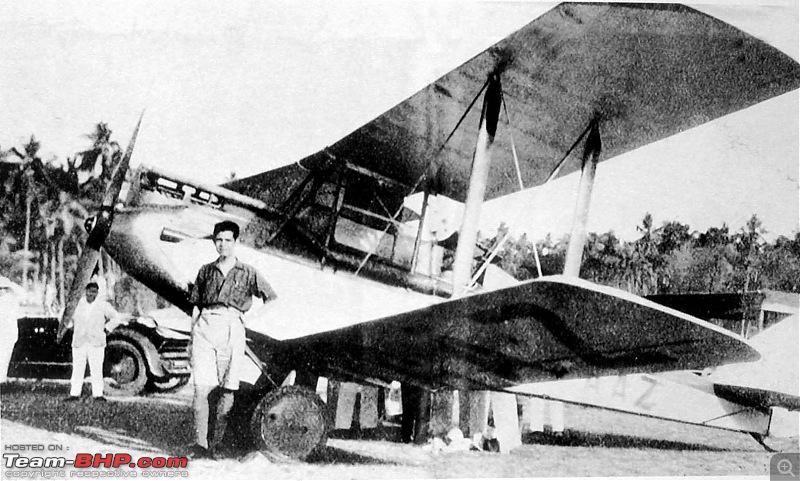 Aspy Merwan Engineer (1912-2002) an all time aviation great of India who has not got his due recognition. At the tender age of 17, in 1929, he flew solo from England to India in a de Havilland Gypsy Moth and won the Aga Khan prize of GBP 500 -Rs 25 lakhs today. He did this in an era when you navigated by the sun, the star and the railway track below and guessed the speed & direction of the wind. He did not have a driving license yet! The aircraft, above, that he flew was powered by a 100 hp engine and cruised at ~140kmph. And we complain today of cars being underpowered at 100 hp! Later he was a part of the maiden crew that formed IAF Number One Squadron, served through out World War II, was awarded the prestigious Distinguished Flying Cross (DFC), served as Chairman of HAL and became the second Indian to command the IAF (1960 to 1964). In my opinion his name counts up there with JRD Tata, Subroto Mukherjee and Dr VM Ghatage as one of the greatest contributors to Indian aviation.  !! !!On 15th October 1932, 28 year old JRD Tata took off in a Puss Moth single engine light plane carrying mail from Karachi to Bombay via Ahmedabad. This was the first operational flight of the newly formed Tata Air Services later Air India International. The plane carried 25 kgs of 4-anna mail for the Indian Postal Service. In its first year Tata Air Services flew 2.5 lakh kms carrying 155 passengers and ~10,000 kgs of mail using small single engined machines. On one occasion the passenger sat on the mail bag!  !! !!JRD Tata was awarded the first pilot's license issued in India. Note that India and Burma were seen as one administrative (if not political) geography! How times change.  ## ##Sarla Thakral (1914-2008) became, in 1936, the first woman to earn her pilot's license. Later she also became the first woman to clock 1000 hours of flying. Her first husband PD Sharma was also a pilot and encouraged his wife's desire to fly. She later became a successful businesswomen. She paved the way for the 650+ women pilots serving in India's airlines today. At ~13% India has the highest proportion of women commercial pilots, in its air carriers, in the world.  ## ##International air travel was introduced in India by Imperial Airways a fore runner of today's British Airways. The first London to Karachi flight was completed in 1929. The impetus was to have fast lines of communication with the far flung Empire and exploit the benefits of air mail. In the 1930s this route was dominated by the Handley Page HP.42 - four-engines, 24 passengers, a 160 kmph cruise speed, a lot of noise in the passenger saloon and hot meals served on real china. It was powered by four 490 hp air cooled 9-cylinder engines driving 4-blade propellers. The aircraft flew in the day, the passengers rested over night at posh hotels and had formal dinners and sight seeing in the evenings. It must have been like a long picnic. And yes if you insist on asking the aircraft had a toilet - bigger than the cramped ones we cope with today. Photo above shows a refueling underway in Palestine (now Israel) enroute to India.  ## ##Depart London on a Saturday and arrive Karachi on a Friday. It doesn't get faster. All for GBP 130 one way. That's like about Rs 7 lakhs today. Never complain about air fares again guys. And mind you this is not as long ago as you think. Some of us have fathers who were alive and kicking in 1929! The alternative by ocean liner was 3+ weeks.  $$ $$Timetable and route map of Tata Airlines in 1939.  $$ $$Tata Air Services was re-named Tata Air Lines and modern Douglas DC-3's joined the fleet in 1945. This photo, c.1946.  $$ $$Lockheed Constellation L-749 of Air India International named Malabar Princess, tail number VT-CQP. The first international flight by an Indian carrier was undertaken by this aircraft, Bombay-London in 1948 flown by Capt. KR Gazder and Capt D.K. Jatar. The ~8000 kms journey was staged with refueling stops at Cairo and Geneva. For India, then newly independent, this achievement a first for a third world ex-colony was today's equivalent of a major ISRO rocket launch. The Constellation L-749 cruised at ~500 kmph. The Air India planes were configured for 42 with reclining sleepers for all. Introduced in the mid-1940s the Constellation was the first commercial airliner to be pressurized to fly above the weather, to be properly air conditioned and to be fitted with sound insulation that actually worked. At just under 100 feet in length and a wing span of 120 feet it was a big big aircraft for its time. Note the four Wright turbo-compound piston radial engines each of which delivered 2500 hp and drove the 15 foot diameter props.  $$ $$The first advertisement inserted by Air India in the newspapers. Rs. 1720 plus taxes for a one way business class fare. In those days all seats were the equivalent of today's business class. The hoi-polloi like us didn't travel by air. In today's terms the fare is like ~Rs 2 lakhs. Note the drop in comparison with Imperial Airways 20 years earlier.  In those days Air Mail was the fast way to communicate. Telegrams and trunk calls were too expensive. Emails were not even in science fiction. This first day cover shows stamps from both newly independent India and of King George VI (father of the present Queen Elizabeth II). 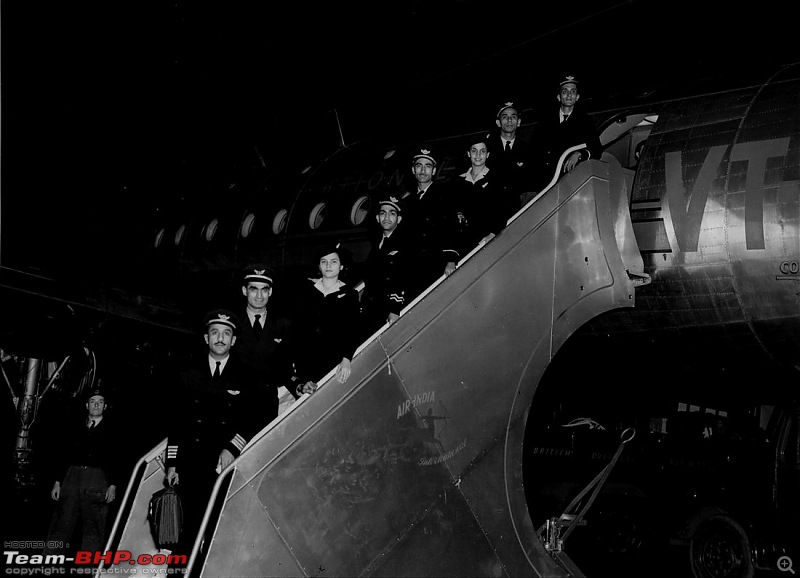 $$ $$1948 - A truly historic photo of the first crew. The forerunners of today's international commercial aviation in India. From L-R Capt DK Jatar, Flight Officer Dhuru, Air Stewardess Miss McCay, Radio Officer Sule, Flight Engineer De'Souza, Air Stewardess Miss Callaway, Navigator Maini, Flight Purser Ganesh. Capt KR Gazder, the commander is taking the photo to mark the landing at London of India's first international flight.  $$ $$Capt KR Gazdar with his mount Malabar Princess. He is a pioneer. Today India is the 3rd largest domestic air passenger market in terms of passenger-miles flown. Only USA and China are bigger.  $$ $$Cockpit of the Constellation. Capt and Co-Pilot up front. Engineer to the right. Navigator to the Left. Radio operator not in picture. Automation and computing power have replaced the last three in modern cockpits.  $$ $$Air India Air Stewardess on a DC-3 Dakota, late-1940s. You can't fault the gentleman on the left for trying.  ## ##A very rare photo of the Vickers Viking in Air India livery. This was a 24-seat short range airliner that emerged soon after World War II. India was one of the larger markets for this simple, rugged but unpressurized machine. In the first decade after independence the Viking along with the Douglas DC-3 Dakota and Douglas DC-4 were the mainstay of our domestic flights. Today this machine has been all but forgotten.  ## ##In March 1953 nine small private air carriers were merged into one public sector Indian Airlines. It was an assumption in the 1950s, 60s & 70s that Government can ran industry better in the national interests than private enterprise!!?!! This assumption that amassed power in the hands of both the bureaucrats and politicians ignored the fact that several infrastructure firsts before 1947 were undertaken by entrepreneurs despite active opposition by the erstwhile colonial Government - Hindustan Aeronautics, Air India, Tata Steel, Hindustan Shipyard, Scindia Steam & Navigation Co. etc. Note the old Indian Airlines livery. 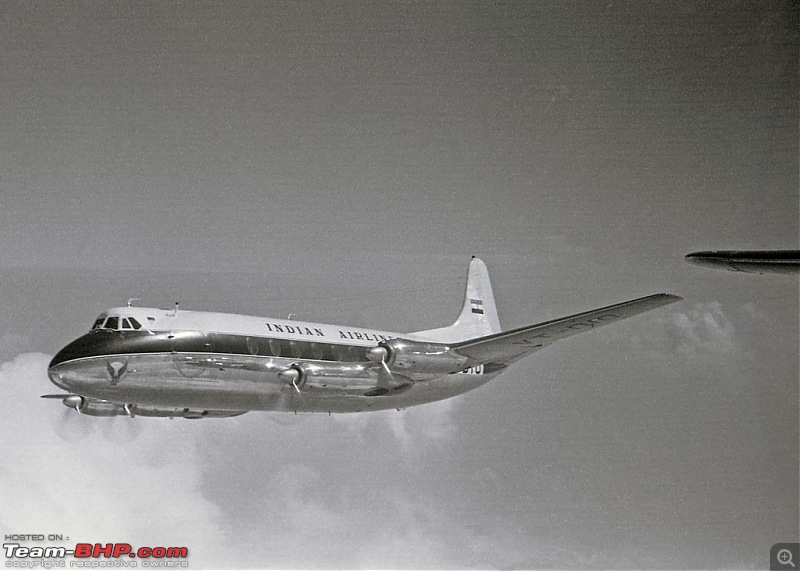 ## ##In 1957 turbine power came to Indian civil skies through the iconic Vickers Viscount V.700D. The British Viscount is the world's first turbine powered airliner driven by four Rolls Royce Dart turboprops. In a turboprop instead of letting the hot fast flowing jet exhaust to dash out of the aft nozzle a power extracting turbine is fitted to suck out the power and use it instead to drive a larger slower propeller in the front - a masterpiece of British innovation. In the 1950s to the 1990s this was a more fuel efficient power plant than a pure jet. India was the first country outside the Western nations to adopt this revolutionary new airliner. It flew faster, above the clouds and most importantly was quiet. For the first time you could have a conversation inside the cabin without stretching your voice. Viscounts flew in Indian skies till the mid-1970s  %% %%Air India's passenger departure lounge at Santacruz Airport, Mumbai c.1949  %% %%Santacruz Airport in c.1952. The tarmac today is packed wing tip to wing tip almost. A Lockheed Constellation of Air India in the foreground.  %% %%And in 1960 Indian civil aviation entered the jet age with the arrival of its first Boeing 707 jet airliner christened Gauri Shankar VT-DJJ. It was received off Mumbai by two Folland Gnats of the IAF. The photo above shows the third Boeing 707 coming in over Mumbai later that year. Air India was the first Asian airline to introduce jet power beating Japan Airlines by a few months. In 1961 with a fleet of six Boeing 707's Air India became the world's first all-jet airline. The airline JRD Tata led & built was a different organism than the one we see today. 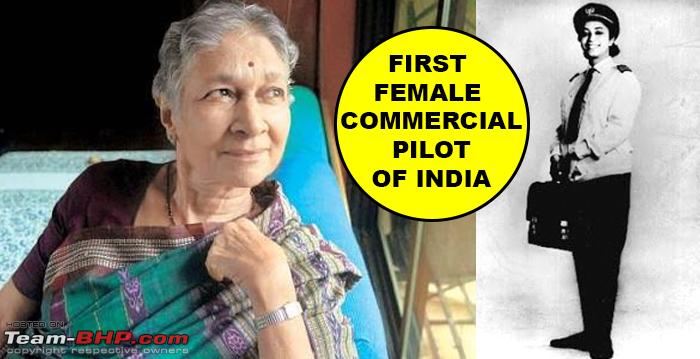 Durba Banerjee, first woman commercial pilot in India, first to earn her wings as a commander, first Indian woman to fly the Boeing 737 and the first woman to fly the Airbus A300. She paved the way for the 700 odd women pilots in Indian commercial aviation which by the way is the highest in the world for any country as a percentage of total commercial pilots. She now lives in Calcutta. When her application to Indian Airlines was turned down this gutsy lady went and met the Civil Aviation Minister Mr Humayun Kabir who was uncomfortable with the idea of a woman pilot and offered her the job of an air hostess instead. Fortunately for Indian aviation Banerjee was made of sterner stuff. We should not judge Mr. Kabir with the lens of 2018 - he was simply a creature of his times the way we are of ours.  Emperor Ashoka VT-EBD the first Boeing 747-200 to join the fleet in 1971. Air India was an early customer of this, the intercontinental range, version of the iconic airliner and with it started the practice of painting little 'jharokas' (traditional window frames) on each window. With this we complete our first chapter on India's civil aviation from the first hop to jet airliners. Picture Sources: %% History of Indian Aviation by Pushpinder Singh $$ Air India Collectors web site ## Wikipedia !! Parsi Khabbar web site Last edited by Akshay1234 : 10th July 2018 at 15:28. Reason: typo |
| |  (124)
Thanks (124)
Thanks
 |
| The following 124 BHPians Thank V.Narayan for this useful post: | aaychat, Abhinav V, abhishek46, AbhisheKulkarni, ACFT, Aditya, AdityaDeane, ads11, aeroamit, agspins, AkMar, Alfresco, alokn87, ampere, AngelDustnBones, ariesonu, Arvi95, arvindmanju, autonarr, av8er, Baddychat, BLACKBLADE, bsdbsd, catchjyoti, CeePee, ChiragM, Comrade, CzechItaliaMoto, damodar, desiaztec, DicKy, digitalsuresh, Doge, download2live, DrANTO, dyer_made, Eshan Joshi, flyboy747, Foxbat, Fraz33r, Full_Minchingu, Fusion2006, ganeshb, Gannu_1, Gansan, GJ01, Grand Drive, GTO, haldar_siliguri, hrman, IcarusMan, InControl, Indicruz, jeeva, JohnyBoy, Joscyriac, JourneyMan, Kandisa, karan561, karlosdeville, karpusv, karuvally, katoom, kaustubh_vaze, keroo1099, kutts, lemedico, Leoshashi, Lively, mac187, Malyaj, manas_270, marcussantiago, Michael_Fanai, neerajdan, Nempuguru, New.Novice, Nohonking, parsh, PGA, PraNeel, PratikPatel, praveen789, promit, quantobigboot, quickdraw, raghu.bramha, Rajeevraj, rameshnanda, Rckz006, RoverX, rrsteer, samsag12, Santosh.Kat, sayakc, sdp1975, shashanka, shivraj737, Shrayus_shirali, Shreyans_Jain, Shubhendra, Shubz, skyocean, SmartCat, sparky@home, SR-71, Srikanthan, Sting, SubhoMoto, suhaas307, sun_king, Sutripta, targaryen, theexperthand, TSIboy, Turbanator, turbospooler, Turbo_ak, VaibhaoT, VeluM, vivek95, wheelguy, yesyeswe, yogesh.8984 |
| |
| | #2 |
| Distinguished - BHPian  Join Date: Aug 2014 Location: Delhi-NCR
Posts: 4,071
Thanked: 64,304 Times
| re: Indian Civil Aviation SEEDS OF THE IAF AND LEARNING TO BUILD AIRCRAFTS The long road..... A few photographs marking the journey of our aircraft building programmes and the early years of the IAF. I am not covering the full history of the IAF as that deserves a thread of its own and I have to sift through over 300 old photos to build that story. It is a story worth narrating.  ## ##Walchand Hirachand founded HAL in 1939 - then named Hindustan Aircraft Ltd, now called Hindustan Aeronautics Ltd. He was a visionary and a risk taker setting up an aircraft assembly plant in 'colonial' India at a time when the colonial rulers were dead against such modernization. He leaned on the Maharaja of Mysore for financial support and the Americans for technical know-how. He also set up the first ship building yard in the country - Scindia Shipyard Ltd, today the Govt. owned Hindustan Shipyard Ltd. His setting up such strategic, long gestation, capital intensive industries put a lie to the industrial policy India followed from 1949 onwards that key industries should be the exclusive preserve of the Govt because private sector would not invest.  ?? ??A Harlow two seat primary trainer takes off creating history. This was an American design and HAL received a license to assemble these small planes. You can see the landing gear folding up into the wings. Sadly I do not know the name of the test pilot. William D Pawley, an American engineer and aviation entrepreneuer came over to India and built the first HAL factory, set up the organization, trained the maiden team and got the first aircraft flying. Pawley later got the US Army Air Force to tie up with HAL to repair their aircraft during WW2 thus laying the foundations of a large scale enterprise. 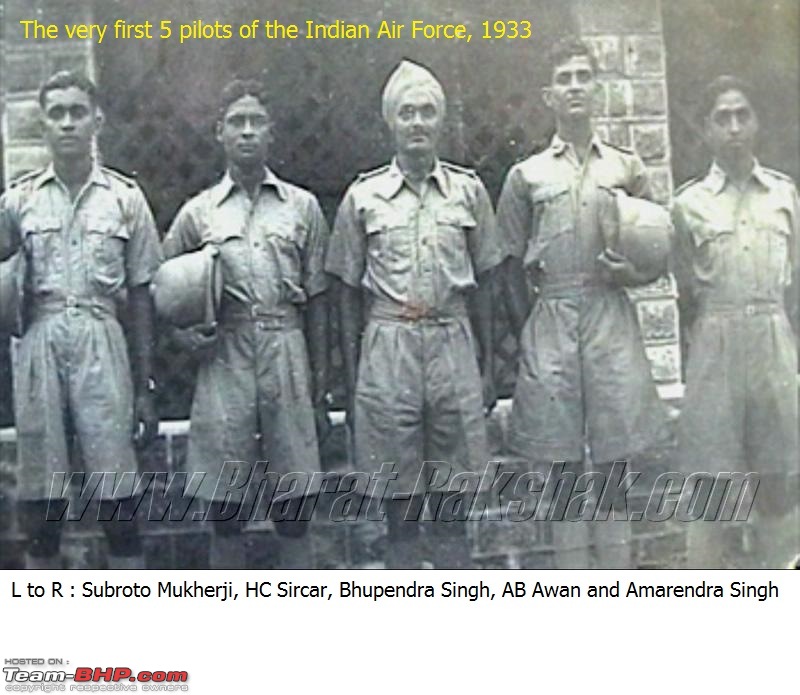 && &&With the Indian Army and Navy it is not possible to pinpoint a date and person with whom it started as they gradually morphed from more than one outfit over the years. In case of the IAF the first 5 pilots are photographed above. Only one of these would survive and continue in the IAF beyond World War II -Subroto Mukherjee - he rose to be the first Indian Chief of the IAF in 1954. AB Awan migrated to Pakistan in 1947 The Indian Air Force was born in October 1932 and went live in 1933. It was meant from the start to be an all Indian force and to act as an aid to the Royal Air force units based in India. A senior British bureaucrat wrote that as we expect to be ruling India for the next 50 years or so we must 'Indianize' a part of the Armed Forces. Such was the thinking at that time.  @@ @@In April 1933 Nos 1 Squadron went operational with its first flight of 5 Westland Wapitis (seen above) and 6 pilots. It was headed by a British RAF officer Flight Lieutenant Cecil Bouchier (red arrow) who to his full credit fought tooth and nail to nurture this fledgling team and protect them as best as he could from the depredations of the other British staff in the RAF. Holding the inspection is Sir Philip Chetwode (blue arrow) who later rose to be a Field Marshal. Sir Chetwode did yeoman service to the cause of Indianizing our Armed Forces and commissioned the Indian Military Academy, Dehradun in 1932. He was a driving force behind the creation of the IAF 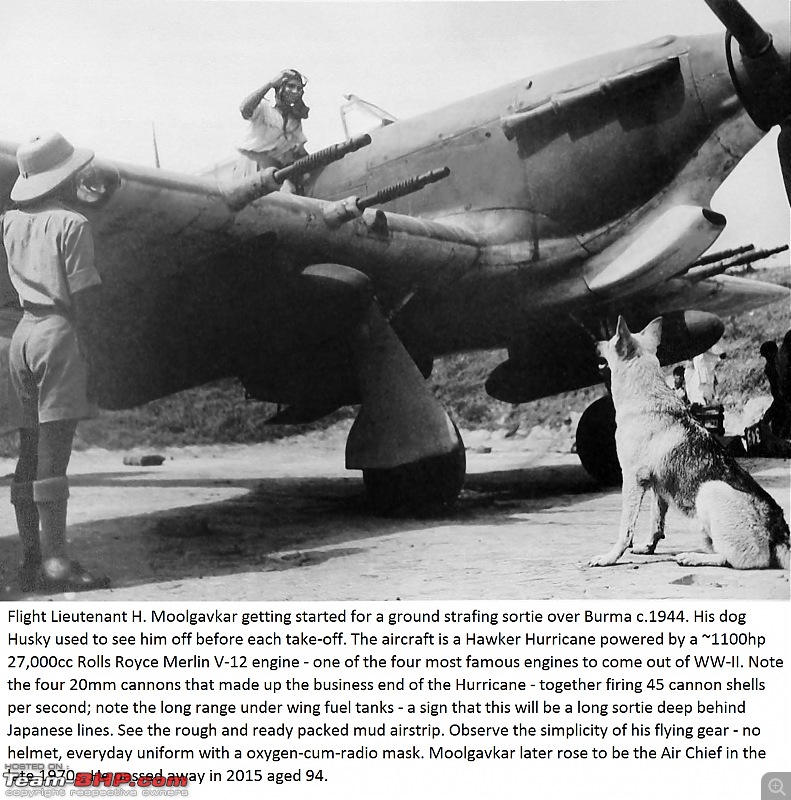 @@ @@ %% %%August 5th, 1951 the Hindustan Trainer HT-2 put sunlight beneath the wings for the first time. Its designer - Dr. VM Ghatge. The aircraft was used for 30 years as the primary lead-in trainer by the Indian Armed Forces and flying clubs around the country. The aircraft was powered by a 155 shp 4-cylinder Cirrus Major inverted in-line engine and flew with a top speed of 209 kmph. When empty it weighed in at 700 kilos. With 172 built the design was more than a moderate success for a pioneer attempt.  %% %%Dr VM Ghatge, in the suit. India's first aircraft designer. Going by numbers built he designed from a clean sheet of paper the three most successful aircraft designs thus far from India - the HT-2 (172) above and the Kiran HJT-16 jet trainer (190) described later and the HAL Pushpak (160) civil trainer and utility aircraft. Figures in brackets are numbers built.  %% %%In the mid-1950s we decided to build a fighter for the IAF under license. The Gnat was selected. This dimutive, super light super maneuverable aircraft caught the eye of Wing Commander PC Lal (later Air Chief in the 1971 war) and Wing Commander Suranjan Das who was India's foremost test pilot. Though rejected in the land of its birth the Folland Gnat was destined to make history 10 years later with the IAF in the 1965 Indo-Pak war. Here you see the first Gnat exported from the UK, into India, being loaded, on a cold English day, into the hold of a C-119G Fairchild military cargo aircraft of the IAF. A few were brought in as CBU units followed by some as CKD and then gradually local manufacture from raw materials started. India built 214 Gnats between 1960 and 1973. Note the wings have been removed to enable the aircraft into the cargo hold. Note the British tractor-trailer lorry. 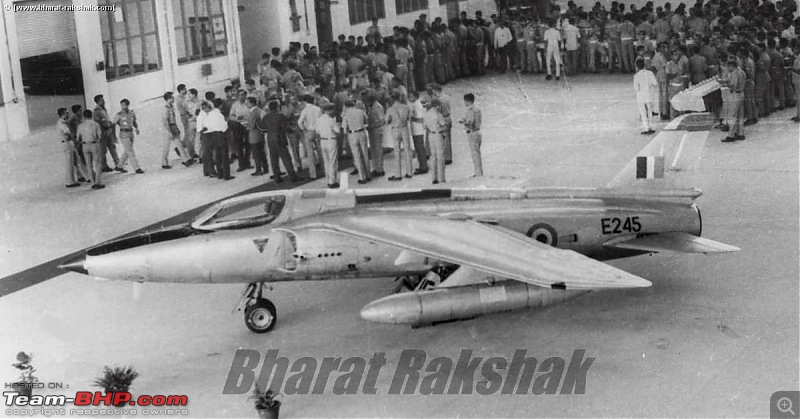 && &&May 1962. The first Gnat produced, at least partly, from local raw materials. Tailfin E245. In the 1960s and 70s the word 'Gnat' was known to every school boy in India. The Gnat had a top speed of 1152 kmph (622 knots) at sea level and an initial climb rate of 20,000 feet a minute. Very respectable figures for the 1950s. Interestingly it was the first jet aircraft in the world whose engine thrust in kgp was greater than its empty weight.  %% %%No story on Indian aviation is complete without Group Captain Suranjan Das. He was one of two of India's first test pilots having graduated from the Empire Test Pilots School, UK in 1949. In his career with the IAF he conducted the bulk of the testing on the HT-2 our very first indigenous design (a single engined trainer), was the chief test pilot for the HF-24 Marut and the first to fly it in 1961, later he was the first to fly and test the HJT-16 Kiran (jet trainer). Once while test flying the Gnat he was doing an eight-point roll. He suddenly felt a restriction in the aileron control and the aircraft going out of his control. Instead of ejecting out and saving his life he very calmly started talking on the radio explaining what was happening and giving his suggestions on corrective measures he was trying to apply to retrieve the aircraft from spiraling into an unrecoverable tail spin. He asked the Air Traffic Control to ensure that his comments were recorded just in case he could not recover and was killed! He did recover and worked with the designers on rectifying the problem and for future pilots to learn what corrective action worked and what didn't. This incident gives us a glimpse into the man and his character. Das was killed in 1970 while testing a Marut version with reheat engines (think of them as the aviation equivalent of turbo charged pistons). He was awarded the Padma Vibhushan posthumously for his services to the nation.  ## ##The Gnat assembly line, HAL Bangalore, 1960s  %% %%Scramble. September 1965. Pilots at a forward base scramble for the fighters as the warning of approaching enemy bogies sounds. 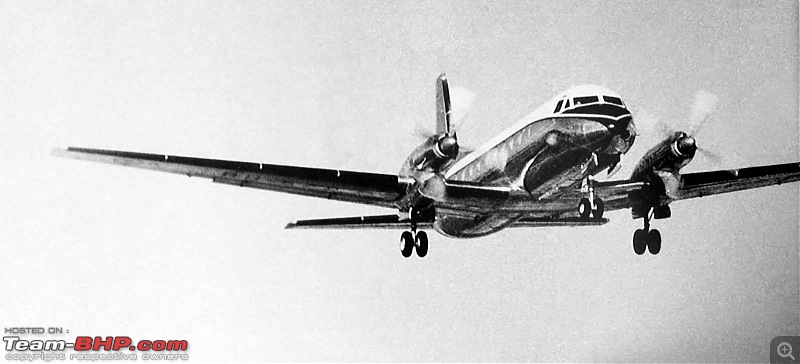 %% %%c.1961 First Avro HS.748 assembled in India on a test flight. The HS.748 was a rugged but under powered aircraft that the then Defence Minister Krishna Menon ordered under pressure from the British without consulting the IAF. also it was not configured as a military transport to start with. PC Lal, who was to later head the IAF in the 1971 Indo-Pak war protested strongly about burning scarce foreign exchange buying a sub-optimal aircraft for which there was no staff requirement either. Long story short he was sacked by Krishna Menon in October 1962. Just as he started preparing for his pre-mature retirement the Indo-China war broke out, we got thrashed, Krishna Menon got sacked by PM Nehru and PC Lal got re-instated and was thus around to help the nation be victorious in December 1971. 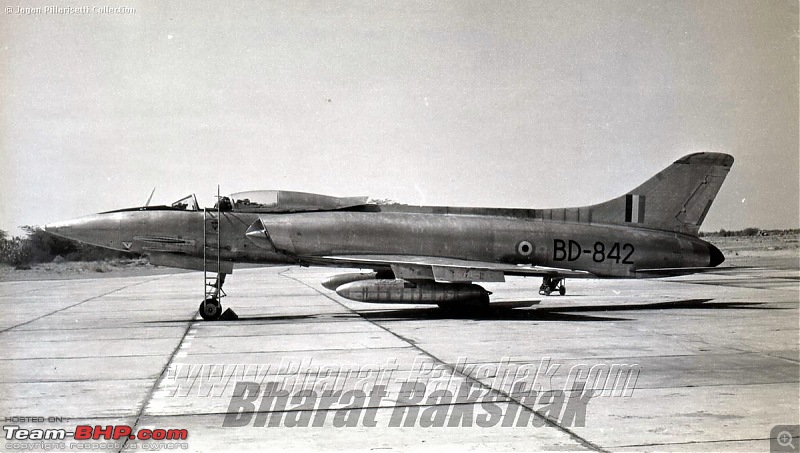 && &&The Marut HF-24 was India’s first indigenous jet fighter and the first supersonic aircraft designed and built outside of the four major powers of USA, USSR, UK, France and Sweden. The first flight took place on 17th June 1961. Whatever else one might say the gumption deserves admiration. The political, bureaucratic and I dare say military hierarchies did not have a proper appreciation of the supply chain infrastructure and quality control challenges that would need to be overcome. Nehru tried to attract leading aeronautical designers from the west to work for India on this project. It was to his credit that, in 1956, he convinced Dr. Kurt Tank (of Focke Wulf fame) to take up this assignment along with his able deputy Engineer Mittelhuber. Under the nose can be seen the two port side 30mm cannons each capable of firing 10 rounds per second. The two pylons on the left wing can be seen with the inner sporting a drop tank. Each pylon was rated for 2000 lbs (~954 kgs) of ordnance. The Marut had a top speed at sea level of 1112 kmph. At full load she could still clip at 1000 kmph. So think of it as zipping along at 1000 kmph with 4 Maruti 800s strapped to your wings.  %% %%Immediately after the first flight of the Marut prototype. It was flown by Chief Test Pilot Wing Commander Suranjan Das (in the flying overalls). Defence Minister Krishna Menon sporting his fuzzy hair. Dr Kurt Tank to his left with the binoculars and Air Marshal Aspy M. Engineer, Chief of the IAF in uniform. You read about him in the first post. 145 Marut were built. They served from the late 1960s to 1990. In 1971 they flew 200 ground attack combat sorties many of which were almost 400 kms deep inside enemy territory. None was lost in dog fights and on one occasion a Marut shot down a Sabre. Apathy from the IAF and our inability to find a suitable engine meant this aircraft never reached its full potential.  %% %% ## ##HJT-16 Kiran. Basic jet trainer that enabled rookie pilot pupils to learn how to handle a jet with its higher speeds and G forces. Designed by Dr. VM Ghatge the Kiran served us for over 45 years and was the cradle in which thousands of Indian military pilots earned their wings. Photo on top of the first prototype on 4th September 1964 the day of its maiden flight. If you look carefully you'll see 'JT-01' written below the cockpit sill. Notice the air intakes placed well above the wing - this was to reduce the risk of ingesting debris.  && &&The very first MiG-21M fighter jet built by HAL. c.1974. The MiG-21 is the most important combat aircraft to serve the IAF in importance, in numbers and in sheer longevity. The 'M' featured here was the second type built in India succeeding the 'FL' and preceding the 'bis'. India built over 600 MiG-21s in addition to about 200 bought from USSR. The upgraded MiG-21 Bison soldiers on and will be retired in 2019 56 years after the first flew with the IAF roundels. The IAF MiG-21s are credited with 8 enemy aircraft destroyed and 3 damaged. In 1971 the MiG-21FLs established, in the first 24 hours, complete air supremacy over what was then East Pakistan and thus gave the Army under Lieutenant General JS Arora the freedom to river jump through that country in 14 days. For those interested in speed the MiG-21 lands at ~320 kmph. As an aside in the Vietnam war the MiG-21 had 56 confirmed victories to its credit. A leading West European fighter test pilot who had flown several Western types and also the MiG-21 (thanks to Egypt after 1974) was asked to compare the following -- MiG-21, the French Mirage III, the British Lightning, the American F-4 Phantom and the American F-104 Starfighter. He started by dismissing the Lightning and Starfighter completely. He admired the Phantom F-4's multi-purpose ability & avionics but rued its inadequate maneuverability. Finally he said in peacetime he would bet on the Mirage III for its better ergonomics and safety and in war he would put all his money on the MiG-21. This was a Western pilot at the height of the Cold War.* *Source: Red Star Rising: Soviet Fighters by Doug Richardson.  %% %%First flight of the prototype HPT-32 primary trainer named Deepak. Dateline 6th January 1977. The Deepak was designed as an ab initio trainer i.e. the first aircraft a pupil learns on. Hence it is light, has a single propeller driven by a 260 shp piston engine and the instructor sits next to you to teach you and scream at you when needed. It was a reasonably successful trainer though. It was a replacement for the HT-2 you see earlier in this post. Sadly 30 years later when time came to replace the Deepak HAL were unable to develop a successor or an acceptable improvement of the Deepak forcing the IAF to purchase the Pilatus PC-7 Mk II from the Swiss. What we could do in 1953 and 1977 we failed to in the present decade.  ?? ??HAL Ajeet prototype on a test flight c.1976. The Ajeet was a great example of how a developing nation should build its aeronautical competence i.e. in steps. Ajeet was an evolutionary development of the proven Gnat fighter with improvements in fuel capacity, gun sights, flight controls, usable weapon pylons, ejection seat and a few others. It stayed in service till 1991. The 1950s to the 1970s were the happy days of Indian aviation design and development. The successes and the enlightened leadership of that time is yet to return. Hopefully progress with the Rudra attack helicopter and Tejas fighter will change that in the next year or two. Jai Hind Photo Sources: %% History of Indian Aviation by Pushpinder Singh ## Wikipedia && Bharat Rakshak ?? The Indian Air Force & its Aircraft, IAF Golden Jubilee 1932-82 by William Green, Gordon Swanborough, Pushpinder Chopra @@THe Eagle Strikes, The Royal Indian Air Force 1932-1950 by Squadron Leader Rana TS Chhina Last edited by V.Narayan : 9th July 2018 at 17:56. |
| |  (104)
Thanks (104)
Thanks
 |
| The following 104 BHPians Thank V.Narayan for this useful post: | aaychat, Abhinav V, ACFT, Aditya, ads11, aeroamit, agspins, akshay380, Alfresco, alokn87, ampere, AngelDustnBones, ant_vas, ariesonu, arijitkanrar, arvindmanju, ashking101, autonarr, av8er, BLACKBLADE, catchjyoti, ChiragM, CzechItaliaMoto, damodar, desiaztec, digitalsuresh, diliprayar, DrANTO, dyer_made, Foxbat, ganeshb, Gannu_1, Gansan, GTO, Harshavarthan, Hayek, i74js, IcarusMan, InControl, Joscyriac, jvm_1986, karlosdeville, karuvally, kaustubh_vaze, keroo1099, KL54, Leoshashi, Lively, LoneRidder, Mahesh Prasad, Malyaj, manas_270, mazda4life, Michael_Fanai, mishraak, Motor_Nut, Nempuguru, nitinmurali, Nohonking, pannags, PapaKiloSierra9, parsh, peterjim13, PGA, Prashant1286, PVS, quantobigboot, quickdraw, Rajeevraj, rameshnanda, Rckz006, RoverX, roy_libran, samabhi, samsag12, Santoshbhat, sarathlal, sayakc, sdp1975, shashanka, shivraj737, skandyhere, skyocean, SmartCat, sparky@home, spikester, Srikanthan, ss1987, Sting, SubhoMoto, suhaas307, sun_king, Sutripta, tharian, theexperthand, the_skyliner, Turbanator, v12, VaibhaoT, VeluM, vinayrathore, yesyeswe, yogesh.8984, Zahoor23 |
| | #3 |
| Team-BHP Support  | re: Indian Civil Aviation Thread moved from the Assembly Line to Commercial Vehicles. Thanks for sharing! |
| |  (2)
Thanks (2)
Thanks
 |
| The following 2 BHPians Thank Aditya for this useful post: | GTO, V.Narayan |
| | #4 |
| Senior - BHPian Join Date: Feb 2005 Location: Melbourne
Posts: 4,376
Thanked: 5,105 Times
| re: Indian Civil Aviation Wonderful thread. What a majestic bird 747 is, that and Air India livery is still a sight to behold. Makes me reminisce the India of old and the Delhi of old where I grew up. It used to be green, not so crowded and I could see the horizon. All that is left now is a crowded mess with horizon replaced by either electric wires or by mini apartment blocks that have taken over almost every individual property in Delhi and absolute civic apathy by those responsible. |
| |  (5)
Thanks (5)
Thanks
 |
| The following 5 BHPians Thank extreme_torque for this useful post: | damodar, desiaztec, Ford5, jeeva, V.Narayan |
| | #5 |
| Distinguished - BHPian  Join Date: Jan 2008 Location: Gurgaon
Posts: 3,838
Thanked: 3,179 Times
| Virtually a story how behind the scenes decisions and greed made all gains to naught in this field. Instead of being producer (like Brazil?) we ended up being consumers. |
| |  (3)
Thanks (3)
Thanks
 |
| The following 3 BHPians Thank sudev for this useful post: | autonarr, extreme_torque, V.Narayan |
| | #6 |
| BHPian | re: Indian Civil Aviation Amazing compilation, appreciate the effort put in Sir. Memory of Gp Capt Suranjan Das lives on as the best test pilot in the Indian TP school each year is awarded trophy instituted in his name. IAF and HAL has always had a tenuous relationship and I am not sure if it has changed for better even now, reasons are kinda known but it has been to the detriment of national interest. |
| |  (1)
Thanks (1)
Thanks
 |
| The following BHPian Thanks PGA for this useful post: | V.Narayan |
| | #7 |
| BHPian Join Date: May 2009 Location: NYC / Lucknow
Posts: 617
Thanked: 3,533 Times
| re: Indian Civil Aviation Yet an another wonderful thread Narayan, you are an absolute treasure trove of Indian Aviation knowledge! I never knew that Air India was one of the first customers for the 747. The 747-200 looks regal in that picture no wonder why you and Skanchan have paid top $$$ for that diecast model. Last edited by Foxbat : 10th July 2018 at 12:18. |
| |  (2)
Thanks (2)
Thanks
 |
| The following 2 BHPians Thank Foxbat for this useful post: | peterjim13, V.Narayan |
| | #8 |
| BHPian Join Date: Jul 2015 Location: Mumbai
Posts: 165
Thanked: 837 Times
| re: Indian Civil Aviation Wow! that was rally very informative and the pictures added a lot to the mood! Thanks for collating it all so well  PS: There is a small typo - Sarla Thakral was born in 1914 but it is mentioned as 2014. |
| |  (1)
Thanks (1)
Thanks
 |
| The following BHPian Thanks praveen789 for this useful post: | V.Narayan |
| | #10 |
| BHPian Join Date: Aug 2004 Location: Trivandrum
Posts: 146
Thanked: 56 Times
| re: Indian Civil Aviation A beautiful photo essay! Thanks so much for enlightening us about the pioneers of Indian aviation, both civil and military, human and mechanical! |
| |  (1)
Thanks (1)
Thanks
 |
| The following BHPian Thanks gkrishk for this useful post: | V.Narayan |
| | #11 |
| BHPian Join Date: Jul 2012 Location: Mumbai
Posts: 583
Thanked: 1,416 Times
| re: Indian Civil Aviation Interesting article, but this does not mention of "Dattabraya Laxuman Patwardhan". I did not know him either, until a very close friend of mine told me that Mr Parwardhan, his great maternal grandfather was the first Indian to Bomb Berlin. There are some books also written on him, but very few know of him. His house in Nagpur is filled with pictures of him during his days with RAF. I have personally not verified this, it is something that my friend mentions proudly and there are bits and pieces on it on the internet. Last edited by Dieselritzer : 10th July 2018 at 14:44. |
| |  (4)
Thanks (4)
Thanks
 |
| The following 4 BHPians Thank Dieselritzer for this useful post: | akshay380, alphadog, Rahul Bhalgat, V.Narayan |
| |
| | #12 |
| BHPian Join Date: Sep 2011 Location: Goa
Posts: 968
Thanked: 1,293 Times
| re: Indian Civil Aviation
Do you have any source regarding his pics in RAF uniform? There are lot of inconsistencies in information regarding him for eg RAF personnel register not having anyone with that name or that Berlin was not bombed at all on some of the days the articles state that it was bombed by his team. TIA! |
| |  (1)
Thanks (1)
Thanks
 |
| The following BHPian Thanks akshay380 for this useful post: | V.Narayan |
| | #13 | |
| Distinguished - BHPian  Join Date: Aug 2014 Location: Delhi-NCR
Posts: 4,071
Thanked: 64,304 Times
| re: Indian Civil Aviation Quote:
One needs to be very careful about anonymous articles, threads, posts and chats on the internet written by people hiding behind pseudonyms (today called handles) who copy paste. Repeating a piece of fiction a dozen times in anonymous articles does not make it a fact. I have read the internet articles claiming he was the first Indian to bomb Berlin. The source is an article written in 1919 in a Marathi newspaper. That story has circulated on the internet several times. Sounds like a very very very long stretch as the RFC to best of my knowledge (and I am available to be corrected) never ever managed to bomb Berlin because the basic aircraft of those days had neither the range nor the navigational capabilities to fly from the Western front in France 600 kms to Berlin and back. So unsubstantiated claims are easy to make in newspapers and the net but the facts don't bear them out. If you are looking for the first person of Indian origin to ever fly then it may possibly be Prof Venkata Subba Setti in England while working on the design and testing of the Avro 504. However written records are not available though photos are of him doing what might be ground runs. I mean no disrespect to Mr Patwardhan who was a fine man who obviously served well in the RFC and was promoted to Honorary Lieutenant as a recognition. Your friend can easily verify the facts if this family belief is true or not. The British are excellent record keepers. Your friend can write to the Air Chief of the RAF and enquire and I am very sure your friend will be directed to the archives or correct source that will tell him - (a) was Berlin ever bombed; if yes (b) did an Indian named Patwardhan fly on the mission. Unlike the Indian Govt the RAF will give you a reply. I know this from happy personal experience while researching a great grandfather who served as a doctor in the Boer War in ~1899-1900 and on my own father who trained under them immediately after independence. In my Dad's case I only asked which ship he trained on and they even told me of some rules he broke as a cadet and what punishment he received. I would encourage your friend to check the facts with British archives. Last edited by V.Narayan : 10th July 2018 at 15:55. | |
| |  (19)
Thanks (19)
Thanks
 |
| The following 19 BHPians Thank V.Narayan for this useful post: | aeroamit, akshay380, Alfresco, alphadog, autonarr, desiaztec, Foxbat, Gannu_1, kaustubh_vaze, Kool_Kid, manas_270, Motor_Nut, Nohonking, peterjim13, shashanka, Shubhendra, Shubz, turbospooler, vinayrathore |
| | #14 | |
| Senior - BHPian Join Date: Apr 2018 Location: Bangalore
Posts: 1,548
Thanked: 17,364 Times
| re: Indian Civil Aviation An amazing thread jammed full of facts.  I learnt a lot about India's aviation history reading this. Thanks for that. I learnt a lot about India's aviation history reading this. Thanks for that.Air India was one of the best airlines in the world back then. So many firsts. Wonder where they lost the way. So wish that they get back to what they were known for before. Quote:
| |
| |  (1)
Thanks (1)
Thanks
 |
| The following BHPian Thanks ChiragM for this useful post: | V.Narayan |
| | #15 |
| BHPian Join Date: Jun 2010 Location: Bangalore
Posts: 761
Thanked: 2,057 Times
| re: Indian Civil Aviation |
| |  (1)
Thanks (1)
Thanks
 |
| The following BHPian Thanks pannags for this useful post: | V.Narayan |
 |


